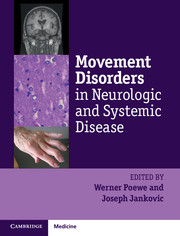Book contents
- Frontmatter
- Contents
- List of contributors
- List of videos
- List of abbreviations
- Preface
- Section I General principles
- Section II Movement disorders in systemic disease
- Section III Iatrogenic and toxic movement disorders
- Section IV Movement disorders in general neurology
- Chapter 17 Movement disorders in stroke
- Chapter 18 Movement disorders in multiple sclerosis
- Chapter 19 Movement disorders in neoplastic brain disease
- Chapter 20 Movement disorders in encephalitis
- Chapter 21 Sleep-related movement disorders
- Chapter 22 The borderland between epilepsy and movement disorders
- Chapter 23 Movement disorders associated with neuromuscular disorders and peripheral neuropathies
- Section V Systemic complications of movement disorders
- Index
- Plate Section
- References
Chapter 18 - Movement disorders in multiple sclerosis
from Section IV - Movement disorders in general neurology
Published online by Cambridge University Press: 05 April 2014
- Frontmatter
- Contents
- List of contributors
- List of videos
- List of abbreviations
- Preface
- Section I General principles
- Section II Movement disorders in systemic disease
- Section III Iatrogenic and toxic movement disorders
- Section IV Movement disorders in general neurology
- Chapter 17 Movement disorders in stroke
- Chapter 18 Movement disorders in multiple sclerosis
- Chapter 19 Movement disorders in neoplastic brain disease
- Chapter 20 Movement disorders in encephalitis
- Chapter 21 Sleep-related movement disorders
- Chapter 22 The borderland between epilepsy and movement disorders
- Chapter 23 Movement disorders associated with neuromuscular disorders and peripheral neuropathies
- Section V Systemic complications of movement disorders
- Index
- Plate Section
- References
Summary
Introduction
Multiple sclerosis (MS) is the main cause of non-traumatic chronic disability in young adults with neurological disorders (Ramagopalan and Sadovnick 2011). Clinical manifestations are provoked by multifocal demyelination and axonal damage in multiple areas of the CNS, causing functional deficit or negative symptoms; positive symptoms completing the clinical spectrum include neuropathic pain and paroxysmal phenomena resulting from inappropriate axon response (Smith and McDonald 2003).
MS presents as one of four distinct clinical variants or forms: relapsing remitting, primary progressive, secondary progressive, or progressive relapsing. Approximately 87 percent of patients show the relapsing remitting form, characterized by acute attacks (relapses), followed by partial or full recovery (remissions) (Weiner 2008). Patients can manifest with a heterogeneous group of symptoms, including changes in vision, lack of coordination, sensory distortion or loss, or changes in bowel or bladder function.
Specific immunomodulatory therapies have shown significant impact on MS natural history. However, even when agents reduce relapse rates and MRI-associated disease activity, they are only partially effective, and do not ameliorate the irreversible axonal damage underlying the most significant symptomatic burden. MS-associated symptom treatment remains an essential cornerstone of comprehensive care for affected patients.
- Type
- Chapter
- Information
- Movement Disorders in Neurologic and Systemic Disease , pp. 268 - 278Publisher: Cambridge University PressPrint publication year: 2014



